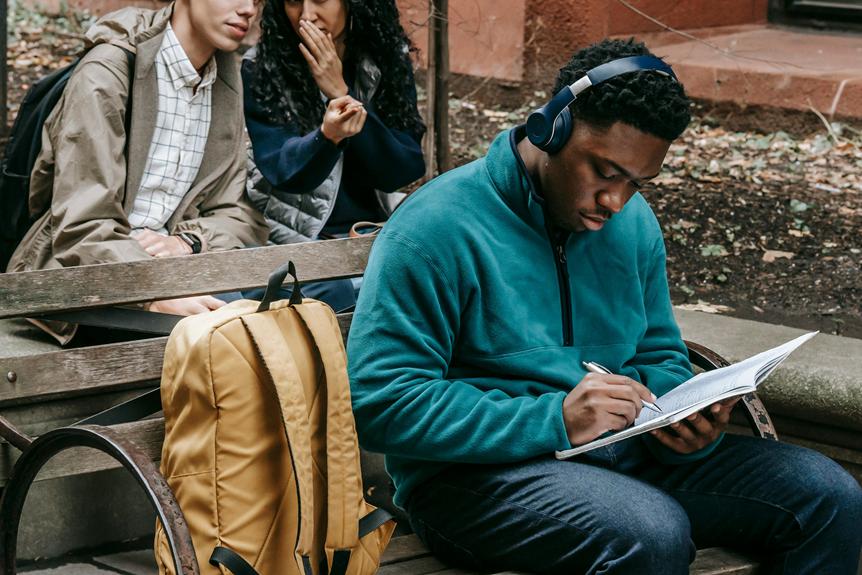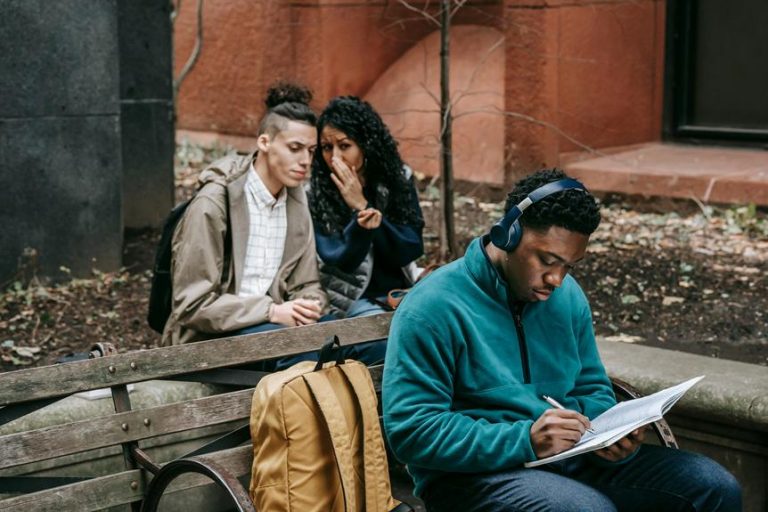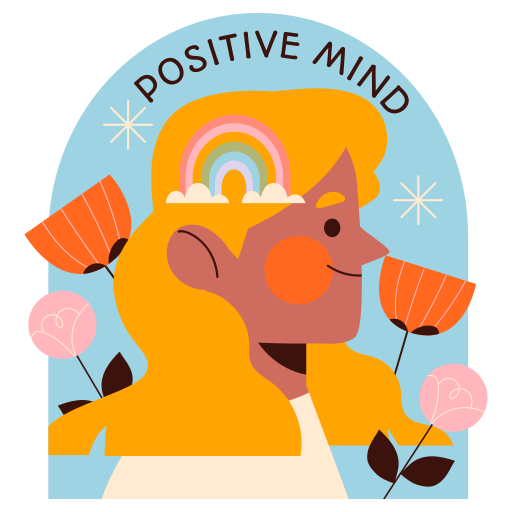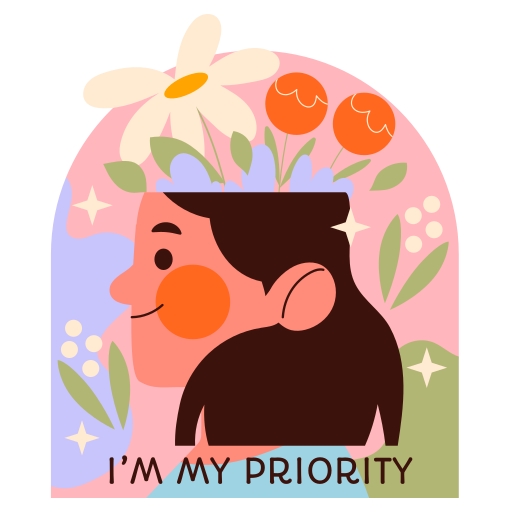Do you ever feel like you're just floating in your own little bubble, disconnected from the world around you? That might be a sign of aloofness, a fancy word for keeping people at arm's length. It's like having a "Do Not Disturb" sign hanging around your neck!
Imagine not really feeling the warmth in conversations, preferring to be alone in your own thoughts instead. That's what being aloof can look like. Sometimes, it's like putting up an invisible wall between you and others without even realizing it.
Have you ever noticed someone crossing their arms tightly or avoiding eye contact? Those are classic signs of someone who might be feeling aloof. It's like they're saying, "Stay away, I need my space!"
But here's the thing – understanding these signs can help us break down those barriers and build stronger connections with others. It's all about opening up, letting people in, and growing together. So, next time you catch yourself feeling a bit distant, maybe it's time to break free from that aloofness and let the sunshine in!
Behaviors in Conversations
In interpersonal interactions, individuals exhibiting distant tendencies often display distinct behaviors in conversations that can hinder meaningful engagement and connection. Distant people may struggle with expressing emotions openly and engaging in small talk that deepens relationships. They might avoid making eye contact, exhibit closed body language like crossed arms, and show reluctance in asking open-ended questions to sustain conversations. This behavior can give the impression of disinterest or detachment, making it challenging to establish genuine connections with others. To combat distance, individuals should work on expressing genuine interest in what others have to say, actively listening, and avoiding dominating conversations. By maintaining brevity in responses and showing curiosity in others' perspectives, distant individuals can gradually enhance their communication skills and build closer relationships. Embracing vulnerability, sharing personal details, and engaging in meaningful dialogues can help break down barriers and foster more authentic connections in social interactions.
Body Language Cues
When observing body language cues, closed-off postures, lack of eye contact, and minimal facial expressions are key indicators of aloof behavior. These behaviors can create a barrier between individuals, signaling disinterest or a preference for solitude. Understanding these nonverbal signals is paramount in recognizing and addressing potential aloofness in social interactions.
Closed-Off Posture
Indications of aloofness can often be observed through closed-off posture, which encompasses various body language cues that convey emotional distance in communication. Closed-off posture may include crossed arms, turned away body orientation, and avoiding direct facing of others. Limited gestures and minimal body movement signal a lack of engagement and interest, contributing to a sense of aloofness. The absence of mirroring or responsiveness to others' body language cues can indicate emotional distance and disinterest in the interaction. Standing or sitting with a physical barrier between oneself and others serves as a visible representation of aloof behavior. Avoiding physical touch or contact reinforces the perception of being emotionally unavailable or aloof in social settings.
Lack of Eye Contact
Closed-off posture, such as crossed arms and turned away body orientation, can often lead to the noticeable lack of eye contact, a common body language cue associated with aloofness in social interactions. Avoiding eye contact indicates a lack of engagement and can create a sense of emotional distance in conversations. Individuals displaying limited eye contact may be signaling a desire to maintain personal boundaries or a discomfort with intimacy. This behavior can convey detachment or disinterest, contributing to the perception of emotional distance. Recognizing these body language cues, such as avoiding eye contact, is crucial in identifying signs of aloofness in social interactions. By understanding the significance of eye contact in communication, one can navigate social interactions more effectively and bridge potential gaps in engagement.
Minimal Facial Expressions
Aloof individuals often exhibit minimal facial expressions, which can serve as significant body language cues indicating emotional detachment or disinterest in social interactions. This lack of animated facial expressions, such as a lack of smiles or frowns, is a common trait among aloof individuals. Limited eye contact and a neutral facial expression further emphasize their emotional barriers. These individuals may present rigid or tense facial muscles, reflecting their inner emotional detachment. Moreover, facial cues like raised eyebrows or a furrowed brow, which typically convey emotions, may be minimal or muted in aloof individuals. All these factors contribute to the overall impression of aloofness projected through their facial expressions.
| Facial Expressions | Body Language Cues |
|---|---|
| Lack of smiles | Emotional detachment |
| Limited eye contact | Disinterest |
| Neutral expression | Emotional barriers |
Communication Style Indicators
Individuals who exhibit aloof behavior often display specific communication style indicators that can be observed in their interactions with others. Some key indicators of an aloof communication style include:
- Avoiding Eye Contact and Physical Touch: Aloof individuals may shy away from making eye contact and engaging in physical touch during conversations, creating a sense of emotional distance.
- Engaging in Surface-Level Conversations: Aloof individuals tend to stick to superficial topics and struggle to express their deeper emotions, leading to a lack of meaningful connection in their interactions.
- Limited Engagement and Solitude Preference: Aloof individuals may show a preference for solitude and limited engagement in group discussions, making it challenging for them to actively participate or connect with others.
These communication style indicators can manifest through various behaviors such as difficulty initiating conversations, expressing needs, and closed body language, ultimately contributing to a sense of aloofness in social interactions.
Social Interaction Patterns

In social settings, the interaction patterns of individuals demonstrating aloof behavior often reflect a tendency towards maintaining emotional distance and limited engagement with others. Aloof individuals tend to avoid eye contact and physical touch, making it challenging to establish connections on a deeper level. They may engage in superficial conversations as a way to navigate social interactions without revealing much about themselves. Expressing emotions openly can be difficult for them due to trust issues, which hinder the formation of close relationships. Their closed body language and lack of emotional engagement can lead to misunderstandings, as others may misinterpret their aloof demeanor as disinterest or coldness. Overcoming these social interaction patterns requires a conscious effort to work on building trust, expressing emotions more freely, and engaging with others in a more open and approachable manner.
| Social Interaction Patterns | |
|---|---|
| Eye Contact | Avoided |
| Physical Touch | Limited |
| Superficial Conversations | Common |
| Express Emotions | Challenging |
Personal Boundaries and Preferences
With a strong emphasis on personal boundaries and preferences, individuals demonstrating aloof behavior showcase a distinct inclination towards solitude and quality relationships. They prioritize meaningful discussions and deep connections over superficial interactions, valuing quality over quantity in their relationships. Here are some key aspects that characterize their personal boundaries and preferences:
- Solitude for Pursuit: Aloof individuals often seek solitude as a means to recharge and reflect, finding pursuit in moments of introspection and personal space.
- Emotional Protection: Their aloof demeanor may stem from a need for emotional protection, as they guard their feelings and vulnerabilities closely to maintain a sense of autonomy and independence.
- Self-Sufficiency in Relationships: Preferring self-sufficiency, they value independence and may appear detached to others due to their ability to navigate life without relying heavily on external validation or support.
These individuals pursue meaningful connections that align with their values, fostering relationships that are built on trust, respect, and mutual understanding.
Emotional Expression Tendencies

Amid their preference for solitude and guarded emotional boundaries, aloof individuals typically exhibit reserved and discreet tendencies when it comes to expressing their emotions. This reserved nature often leads them to keep their private feelings to themselves, appearing emotionally distant or detached from others. Aloof individuals find it challenging to express emotions openly, which can hinder their ability to form deep emotional connections with those around them. Due to their inclination to keep personal details private, they may come across as uninterested in discussing feelings or emotions with others. The reluctance to show vulnerability or engage in conversations about personal emotions can contribute to the perception of aloofness. For these individuals, expressing emotions may feel uncomfortable or unnecessary, leading to a preference for maintaining emotional distance in their interactions.
Frequently Asked Questions
How Does an Aloof Person Act?
How does an aloof person act? Aloof individuals exhibit reserved body language, struggle with emotional detachment, communicate sparingly, isolate themselves, lack empathy, avoid deep interactions, maintain distant relationships, and may be misunderstood due to their introverted and guarded demeanor.
What Causes a Person to Be Aloof?
Introverted tendencies, fear of vulnerability, social anxiety, past experiences, lack of emotional connection, misunderstood behavior, self-preservation, avoiding intimacy, difficulty expressing emotions, and coping mechanism can cause aloofness. These factors contribute to emotional distance and detachment.
What Is an Aloof Personality Type?
An aloof personality type is characterized by introverted tendencies, social detachment, emotional distance, self-isolation, lack of engagement, a cool demeanor, disinterested behavior, distant relationships, an unapproachable aura, and an independent mindset.
Can You Be Aloof but Friendly?
In steering social boundaries, individuals can achieve an approachability balance by exhibiting a friendly demeanor while maintaining emotional availability. Engaging presence, warm interactions, and strong conversational skills can coexist with introverted tendencies, creating a unique but welcoming social disconnect.

















